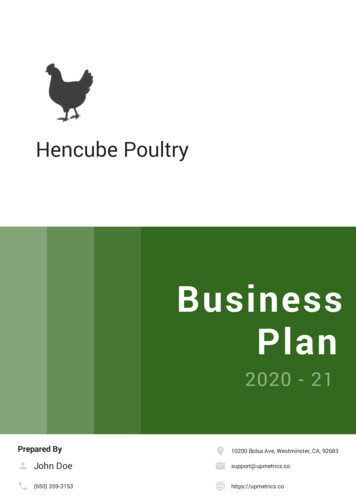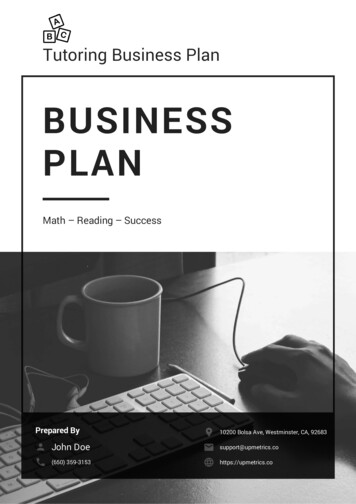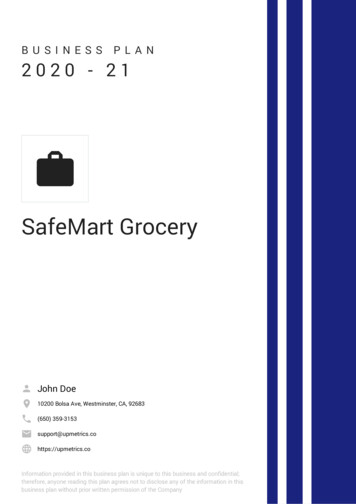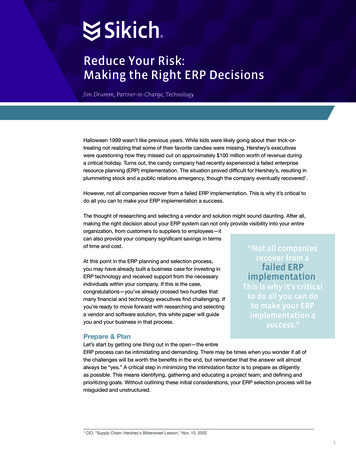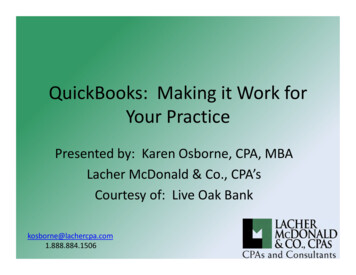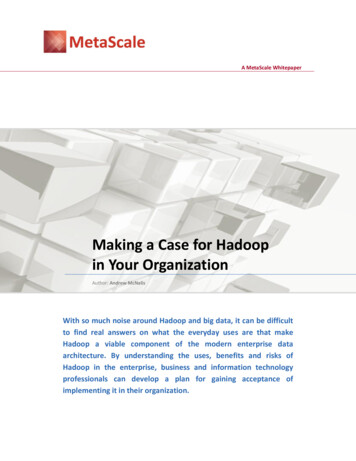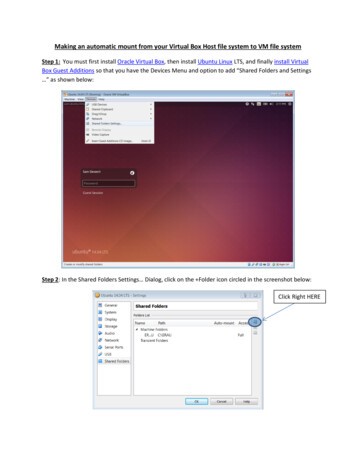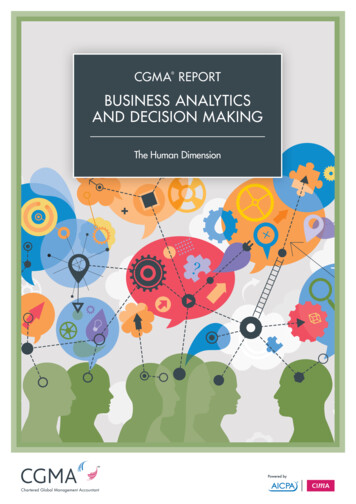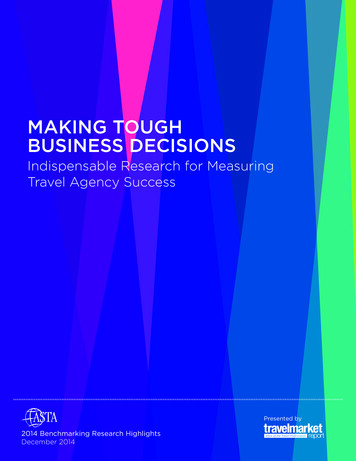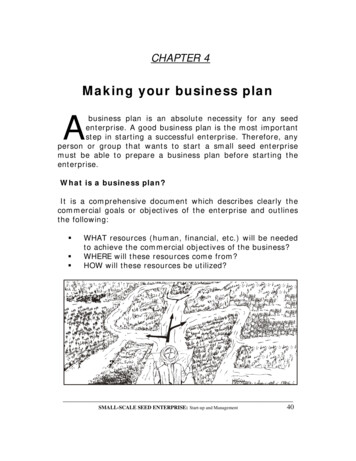
Transcription
CHAPTER 4Making your business planAbusiness plan is an absolute necessity for any seedenterprise. A good business plan is the most importantstep in starting a successful enterprise. Therefore, anyperson or group that wants to start a small seed enterprisemust be able to prepare a business plan before starting theenterprise.What is a business plan?It is a comprehensive document which describes clearly thecommercial goals or objectives of the enterprise and outlinesthe following: WHAT resources (human, financial, etc.) will be neededto achieve the commercial objectives of the business?WHERE will these resources come from?HOW will these resources be utilized?SMALL-SCALE SEED ENTERPRISE: Start-up and Management40
The business plan is a road map to success. It shows youthe direction to follow, which may not always be a straightroad. This means that as you move along, you have to checkperiodically whether you are in the right direction or not. Youdon’t wait until you get lost. If you are moving in the wrongdirection, take corrective action quickly to get back on theright trackWhy do you need a Business Plan?As an entrepreneur, you need a business plan for thefollowing reasons:i.To show the cash flow you expect or how much moneyyou expect to spend on the business in comparison withhow much you will bring into the business during agiven period of time.ii.To show which operations you will undertake and howmuch money you will spend on such operations.iii.To show funding or credit agencies how much yourenterprise is worth and how well it will do in the future.iv.To assess the chance of the enterprise and makenecessary correction before starting the business so asto increase you possibility of success.v.To minimize risks by preparing a plan that will guidethe operation of you enterprise and serve as continuousreference.vi.To promote and market your enterprisevii.To show how you will achieve your business goals andobjectives.SMALL-SCALE SEED ENTERPRISE: Start-up and Management41
What should your business plan contain?Your plan should be simple, but it should detail theresources you will use, where these will come from, andhow you will operate and manage the enterprise. Thefollowing is a simplified outline of the major components ofa business plan:Cover page1. Introduction2. Operating plan3. Financial plan4. Marketing plan5. Management plan6. ConclusionsPreparing aenterprisesimpleBusinessplanforyourseedTo prepare a good business plan, you should think howanswer the following questions carefully:COVER PAGEYour cover page should provide essential information: What is the name of your group enterprise? What is the contact address of the enterprise? What are you telephone numbers and e-mail address? What is the logo of the enterprise? (This should be simple) What is your business slogan? (This should be short,attractive and to the point) When was the business plan prepared? (month and year)SMALL-SCALE SEED ENTERPRISE: Start-up and Management42
Sample Cover Page:SMALL-SCALE SEED ENTERPRISE: Start-up and Management43
1.INTRODUCTIONIn preparing your introduction you should attempt to answer thefollowing questions:What is the name of the enterprise? What is the structure andownership of the business and total number of members? Whatis the objective of the group coming together to form theenterprise or start the business? What does the group expectto achieve by coming together? Why do you select to go into a seed business? For example,is it based on your long involvement in seed production or onskills and experience the members would bring to the business(specify these), or on potential market demand? What are theadvantages your enterprise may have over competing ones? Isthere any other special reason for selecting the seed business? What type of crops varieties and seed will your groupenterprise produce and sell, and what is the potential marketor groups of farmers that will buy it? What will be the possibleadvantages of your varieties/seed? (higher yield, shorterduration, disease tolerant, cheaper, better quality, etc.) What are your perspectives about the profitability, futuregrowth and success of your group enterprise? Sample Introduction:Best Afghan Seeds (BAS) is a pilot seed enterprise that will beestablished with the technical assistance of FAO of the United Nations aspart of its Seed Industry Commercialization Programme. Ten leadingfarmers with long years of seed production experience as contractgrowers will pool their resources together including land and money toestablish the enterprise.BAS Seed Enterprise will rely on the proven knowledge, skills andexperience of its Leader, Mr.Abdul Rasheed, who brings over a decadeof seed company managerial experience to the enterprise. AssistingMr.Rasheed will be Mr. Mohammad Naweed, who has considerabletechnical experience in seed production and can meet the high qualitystandards that BAS Enterprise has set for its seed.SMALL-SCALE SEED ENTERPRISE: Start-up and Management44
BAS Seed Enterprise will be created for the primary purpose of providinghigh quality seed of the best wheat and rice varieties to farmers in thenorthern and northeastern regions of Afghanistan, which are consideredthe bread basket of the country. The enterprise has a potential to gainreputation for offering quality wheat seed that provides great value tofarmers in irrigated land. It will take advantage of the growing demandfor quality seed of new wheat and rice varieties with outstanding flourand cooking qualities respectively.BAS Seed Enterprise will establish its base of operations at Pulikhumri,the capital of Baghlan Province, which has amongst the largest area ofirrigated land in the country and the fastest growing market forimproved seed of wheat and rice. Other existing suppliers in Baghlanprovince produce seed of either traditional varieties, or old improvedvarieties that no longer perform well. BAS enterprise will therefore be ina good position to capture a significant portion of the local market forwheat and rise seed, since it will introduce new and better performingvarieties.BAS Seed Enterprise will differentiate itself from other suppliers throughlower pricing and unique promotional techniques. By specializing in justa few of the most popular varieties, BAS Seed Enterprise will gainaccess to the largest segment of a growing seed market for wheat andrice. This tightly focused approach will also make it easier for BAS SeedEnterprise to establish and attain the position of a seed industry leader.This enterprise is projected to return a profit margin of 46% in its veryfirst year of operations, due in a large part to the size of the market, acompetitive price for seed, and the relatively low investment required tobegin operations. The first year (2007) sales revenue is projected toexceed 47, 000. The profit that is generated will be used forreinvestment in the enterprise.2.OPERATING PLANYour Operating plan should explain how the enterprise willfunction on a day-to-day basis. How will you obtain land for your enterprise to establishoffices and stores, and to produce different types ofseed requiring different agro – ecological conditions? Which equipment, facilities and materials will you needand what is the estimate of their costs? Why would youneed these specific types of equipment or facilities?SMALL-SCALE SEED ENTERPRISE: Start-up and Management45
What production inputs will be required and how muchwill these cost? What will be the production and delivery process ofyour seed from the initial to final stages? How much time will be required for the production anddelivery process until the seed finally reaches farmersfor planting? What expertise and skills will be needed for theproduction and delivery processes and how will thesebe obtained?Sample Operating Plan:Based on a survey of farmers in North and Northeastern Afghanistan, it hasbeen determined that the current total annual requirement for wheat seedis about 125,000 tonnes and 10,000 tonnes for rice seed. Most farmers useolder varieties and use their own farm-saved seed. This own seed is of poorquality and the varieties are mixed. There is therefore a persistent highdemand for quality seed of new varieties, for which the farmers areprepared to pay higher prices.BAS plans to enter the market and sell a total of 10,500 seers and 14,300seers (1 seer 7 kg seed) of certified seed respectively of new wheat andrice varieties in the first two seasons of operation (20 months startingOctober in year1) and increasing this gradually to a combined total of about50,000 seers by the fifth year. For this, the owners will contribute someland each and the enterprise will also sign contract with growers andproduce most of the seed on their own lands. The enterprise will need initialcapital to construct a store with sufficient office space, and buy furniture, aseed cleaning plant, a transport van, three motor cycles, ten bicycles, twocomputers and one printer, and five mobile telephones. In addition, thebusiness will require sufficient working capital to buy necessary inputs(foundation seed, fertilizer, herbicides, packaging material and seedtreatment chemical), to purchase raw seed from contract growers, toundertake post-harvest operations and to meet other day-to-day expenses.The owners will contribute 20% of the funds required, and the enterprisewill need to raise a long-term bank loan for the rest of the amount requiredat 15% service charge.In the first year, BAS enterprise will select key farmers who are alreadyknowledgeable in seed production to grow foundation seed of new irrigatedwheat varieties on contract. One of the enterprise members is anexperienced agronomist who will closely supervise the field operations andSMALL-SCALE SEED ENTERPRISE: Start-up and Management46
coordinate raw seed purchases at harvest time. The owner of BAS has longterm relationships with the area’s best farmers and is confident that eachwill provide quality service.An intensive training programme will be organized for all selectedgrowers prior to their involvement in the programme. A vigorouscampaign will also be mounted to promote the quality of BAS seed inthe farming communities so as to capture a good proportion of the seedmarket and maintain a core of loyal clients.BAS Enterprise will carry out the following key operations:- Purchasing raw certified seed from its contract growers- Cleaning, packaging, treatment and storage of the seed- Seed distribution, marketing and salesThe various components of each operation and the estimated costs areoutlined in the financial plan.3.FINANCIAL PLANYour Financial Plan should discuss the finances you will need andexpect. As a part of your overall financial plan, are costs, salesand profit plans, which should show, estimate or discuss thefollowing:Costs element What will be the total cost of the enterprise or the amount ofinitial finance you will require to start the enterprise andoperate it for one year (investment needs)?- Land and buildings.- Machinery and equipment.- Inputs (foundation seed, fertilizer, etc)- Materials and supplies (packaging, seed treatment,etc.)Administrative costs.Where will you obtain this money?- Own investment (how much of your own resources willbe put into the enterprise at this stage?)SMALL-SCALE SEED ENTERPRISE: Start-up and Management47
-Group investment (How much will come from the members’contribution?)Loan (If you are going to look for a loan, how muchmoney will you be looking for and what collateral securityyou will be able to offer for the loan?)Grant (What will be the possible sources of grant?)Any other sources of fundsWhat will be the fixed and working capital (variable cost)requirements of your enterprise?What will be the projection of costs of your business?Sales element What will be the forecast of total sales (benefit) of yourenterprise?Profit element What will be the projection of profitability (size ofprofits) of your enterprise?Financial statementsHow do you summarize and present the potentialperformance of your enterprise?Having estimated the costs, revenue and profit level inChapter 3, you should be able to present these measures ina summarized form that gives a snapshot of the success ofyour enterprise. The following are three ways of doing this:i)Preparing an operating cash flowAn operating cash flow plan (detail by month for year 1 orseason) On the basis of your operating plan, how much cash willyou expect to come into and go out of your enterpriseeach month? How will you ensure that your enterprise does not runSMALL-SCALE SEED ENTERPRISE: Start-up and Management48
short of cash at any time? Your cash balance in anyone month must not be negative.ii)Preparing a projected profit and loss statement for yourenterprise.You should show the potential profitability of your enterpriseand provide a projected profit and loss statement for Year 1.The profit and loss statement will show what profit or lossyou expect to make at the end of the cropping season. Thisstatement will summarize expenses (or costs) of yourenterprise and the revenue obtained during the year to givetwo totals A and B as follows:Total A (opening value of seed stock expenses duringthe year)Total B (closing value of seed stock revenue receivedduring the year)Expected profit of your enterprise (Total B) – (Total A)A successful seed enterprise should aim at selling all its seedduring the year (no carryover stock) such that both openingand closing value of seed stock equal zero. The profit duringthe year will therefore be determined only by the differencebetween the revenue received and the expenses made.iii)Preparing a net worth or balance sheet for Year 1iv)Sensitivity (“what if”) Analysis What will be the effect on your enterprise of some keyfinancial variables?Accounting recordsHow will you manage and keep your accounting records?SMALL-SCALE SEED ENTERPRISE: Start-up and Management49
SMALL-SCALE SEED ENTERPRISE: Start-up and Management 41 The business plan is a road map to success.It shows you the direction to follow, which may not always be a straight road. This means that as you move along, you have to check

